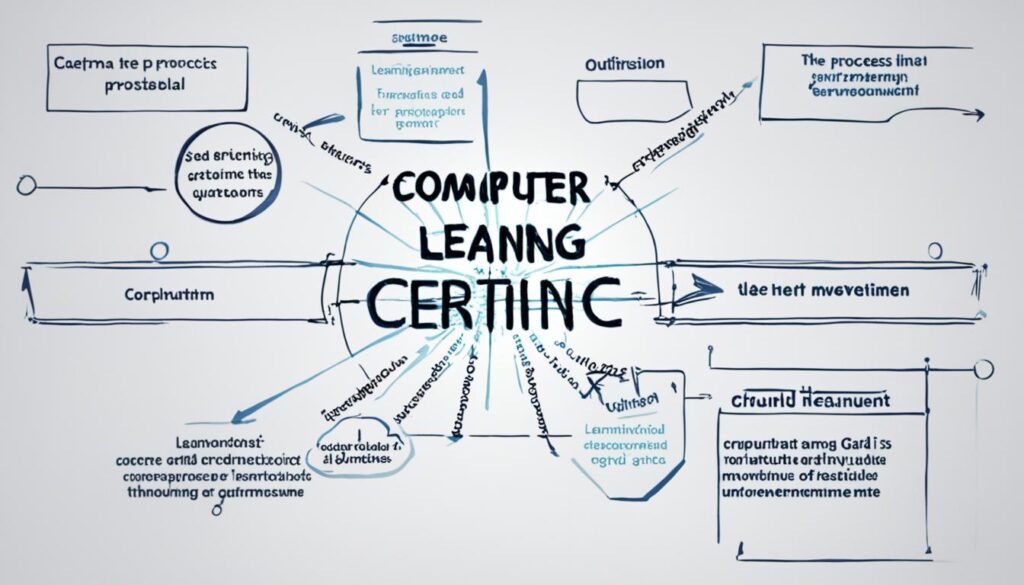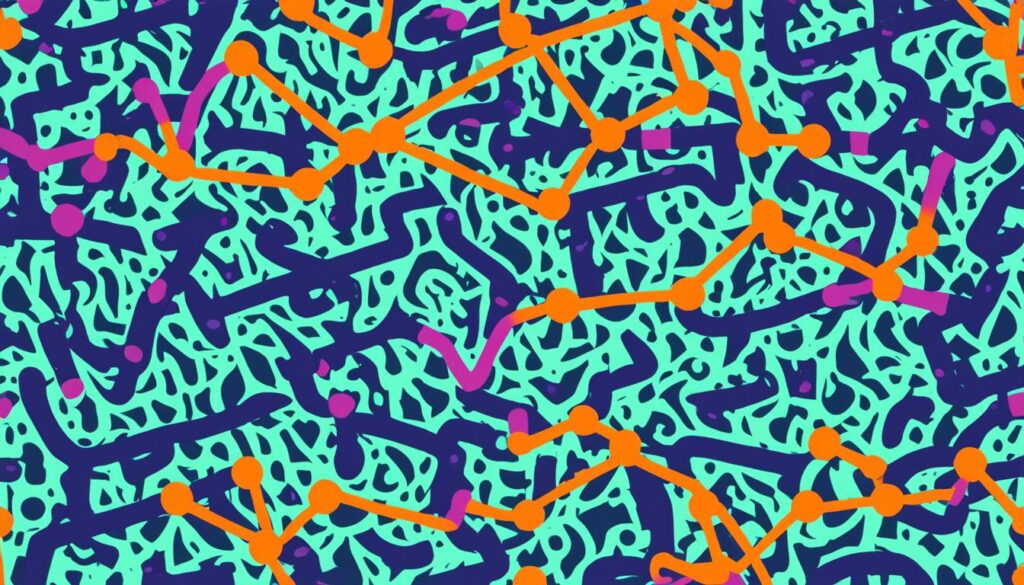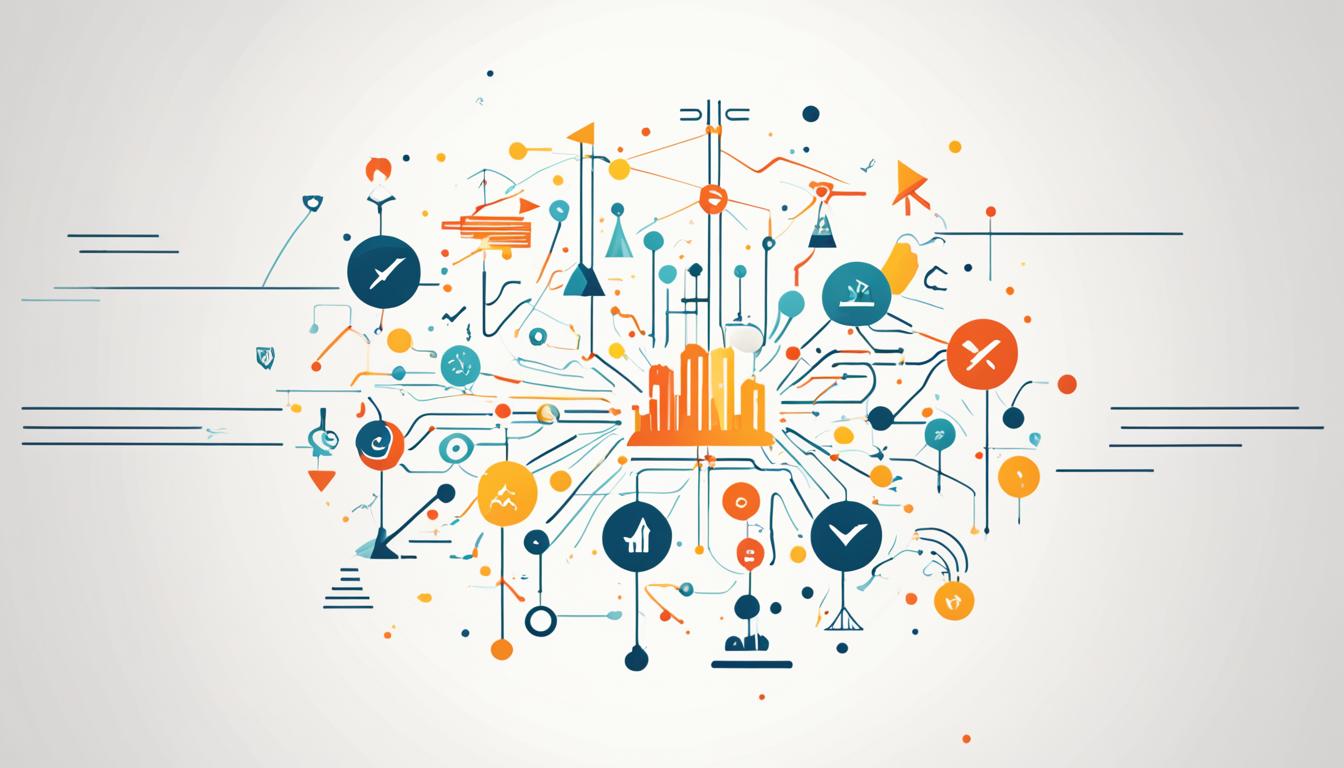Welcome to our introduction to reinforcement learning, a fundamental concept in the field of artificial intelligence (AI) and intelligent systems. In this article, we will explore how machine learning algorithms, specifically reinforcement learning, play a crucial role in teaching agents to make decisions to maximize rewards in various environments.
Reinforcement learning involves a range of algorithms such as Q-learning, policy gradient methods, Monte Carlo methods, and temporal difference learning. These algorithms allow agents to learn through trial and error, leveraging the concept of rewards to guide their decision-making process.
Deep reinforcement learning combines these algorithms with deep neural networks, enabling agents to learn more complex tasks by processing vast amounts of data. This advancement has contributed to breakthroughs in areas such as autonomous vehicles and robotics.
Reinforcement learning can be divided into two main categories: model-based and model-free. In model-based reinforcement learning, agents build an internal representation or model of the environment, which facilitates the development of strategies to achieve specific goals. Model-free reinforcement learning, on the other hand, does not rely on internal models, but rather takes a trial-and-error approach to learn from the environment.
Applications of reinforcement learning are diverse and impactful. For example, reinforcement learning algorithms enable robots to navigate complex environments autonomously, while self-driving cars learn to make real-time decisions in city traffic. These applications showcase the power of reinforcement learning in building intelligent systems.
Key Takeaways:
- Reinforcement learning is a branch of machine learning that focuses on teaching agents to make decisions to maximize rewards.
- Essential algorithms in reinforcement learning include Q-learning, policy gradient methods, Monte Carlo methods, and temporal difference learning.
- Deep reinforcement learning combines these algorithms with deep neural networks for more complex tasks.
- Model-based reinforcement learning involves building an internal representation of the environment, while model-free reinforcement learning relies on a trial-and-error approach.
- Applications of reinforcement learning include robot navigation and self-driving cars.
Model-Based Reinforcement Learning
In model-based reinforcement learning, the agent utilizes a structured approach to understand and interact with its environment. The first step in this process is to build an internal representation or model of the environment. By taking actions in the environment and observing the resulting state and reward, the agent constructs a comprehensive model that captures the dynamics of the environment.
By associating action-state transitions with their corresponding rewards, the agent creates a well-defined model that allows it to simulate different action sequences. Based on the probability of achieving optimal cumulative rewards, the agent can explore and develop strategies within the environment to achieve its goals.
An example that exemplifies model-based RL is a robot learning to navigate a building. The robot explores the building, taking actions such as moving through doorways and hallways. By creating an internal map of the building, the robot can plan efficient paths to different locations based on its understanding of the environment. This enables the robot to make informed decisions and navigate effectively.
Strategies in Model-Based RL
The use of a model in model-based RL enables agents to employ various strategies to maximize rewards. Some common strategies include:
- Planning: Agents can simulate potential action sequences and evaluate the expected cumulative rewards to choose the most promising actions.
- Optimization: Agents can optimize their policies by fine-tuning the parameters of their internal models, improving decision-making and overall performance.
- Exploration: Agents can use their internal models to explore new regions of the environment and discover optimal strategies that were previously unknown.
The availability of a well-defined internal representation allows agents to adapt and refine their strategies based on the specific characteristics of the environment.

Examples of Model-Based RL
Model-based reinforcement learning has been successfully applied to various domains and scenarios. Here are a few examples:
- A drone learning to navigate through a maze-like environment by building an internal map and planning efficient paths.
- A chess AI analyzing potential sequences of moves in order to choose the optimal strategy for victory.
- A recommendation system using a user’s browsing history to model their preferences and suggest personalized content.
These examples demonstrate how model-based RL allows agents to leverage their internal representation and strategic planning to achieve specific objectives within their environments.
Model-Free Reinforcement Learning
Model-free reinforcement learning is a powerful approach used in large and complex environments where the environment dynamics are not easily describable. Unlike model-based RL, where the agent builds an internal model of the environment, model-free RL takes a trial-and-error approach to learn and make decisions.
In model-free RL, the agent learns through interaction with the environment, recording and scoring state-action pairs and sequences of state-action pairs to develop its policy. This trial-and-error process allows the agent to explore different actions and learn from the feedback it receives in the form of rewards or penalties.
The agent’s goal is to maximize rewards over time by continually adjusting its policy based on the outcomes of its actions. By iteratively testing different state-action pairs, the agent learns which actions lead to higher rewards and which ones should be avoided in similar situations.
An excellent example of model-free RL is a self-driving car learning to navigate city traffic. Instead of explicitly modeling the complex and dynamic traffic dynamics, the car relies on trial and error to learn the best actions to take in different traffic scenarios. By observing the state of the environment (e.g., traffic conditions, pedestrians), the car can make well-informed decisions in real-time.
Model-free RL offers a flexible and adaptive solution for complex environments where a clear internal model is challenging to establish. It allows intelligent systems to learn effective strategies without deep knowledge or explicit modeling of the environment dynamics.
Model-free reinforcement learning is a trial-and-error approach that enables agents to learn from experience in complex environments without building an internal model. This flexible and adaptive method has applications in self-driving cars, robotics, and other areas where modeling the environment is challenging.
Benefits of Model-Free Reinforcement Learning
- Adaptability: Model-free RL can adapt to changing environments and learn optimal actions even in situations with unknown dynamics.
- Flexibility: Since it doesn’t require an internal model, model-free RL can be applied to a wide range of complex problems without extensive modeling efforts.
- Ease of Implementation: Model-free RL algorithms can be relatively straightforward to implement as they focus on learning from experience rather than explicit knowledge of the environment.
Challenges of Model-Free Reinforcement Learning
- Exploration-Exploitation Trade-off: Model-free RL faces the challenge of balancing exploration to discover new rewarding actions and exploitation to select known rewarding actions.
- Sample Efficiency: In complex environments, it can require a significant amount of interactions with the environment to converge to an optimal policy.
- Delayed Rewards: Model-free RL algorithms need to handle delayed rewards, as the agent may receive feedback only after a chain of actions, making it challenging to associate actions with specific outcomes.
The trial-and-error nature of model-free reinforcement learning makes it a valuable tool for solving complex problems and enabling agents to learn and adapt in dynamic environments.

Reinforcement Learning vs. Supervised Learning
Reinforcement learning (RL) and supervised learning are two distinct approaches in the field of machine learning. While both methods aim to train models, there are significant differences in their techniques, decision-making processes, and feedback mechanisms.
In supervised learning, models are trained using pre-existing datasets that contain the correct answers or labels for each input. The model learns to generalize from the provided examples to make predictions on new, unseen data. This approach is widely used in tasks such as image classification, text sentiment analysis, and speech recognition.
In contrast, reinforcement learning takes a different approach. RL agents learn from their own experiences by interacting with an environment and receiving feedback in the form of rewards or penalties based on their actions. The sequential nature of RL’s decision-making process is a distinct characteristic. Each decision made by the RL agent depends on previous actions and influences future ones.
Unlike supervised learning, RL does not rely on a predefined dataset with correct answers. Instead, RL models learn through trial and error, exploring different actions and their consequences. This allows RL models to adapt and improve their decision-making abilities over time.
“Reinforcement learning is like teaching a child. You provide feedback based on their actions, and they learn from their experiences to make better decisions.”
Feedback in RL is delayed since it is dependent on the rewards or penalties received by the agent. The agent learns to associate its actions with the outcomes and adjusts its behavior accordingly. In contrast, supervised learning provides prompt feedback based on the correctness of the model’s output.
RL is particularly suitable for problems where there is no predefined answer or labeled dataset available. RL models excel in scenarios where decision-making requires exploration and learning through interacting with the environment. Examples of RL applications include training robots to perform complex tasks, optimizing resource allocation, and developing autonomous agents for games.
To summarize, RL and supervised learning differ in their approaches to learning and decision-making. RL relies on sequential decision-making, feedback based on rewards or penalties, and learning through trial and error. Supervised learning, on the other hand, relies on pre-labeled datasets, prompt feedback, and generalization from known examples. Both approaches have their own strengths and are applicable in different scenarios, depending on the nature of the problem and the availability of labeled data.
Conclusion
Reinforcement learning is a powerful approach to machine learning that enables intelligent systems to learn and improve their decision-making abilities. Its wide range of applications in robotics, autonomous vehicles, and complex environments demonstrates its potential to revolutionize various industries.
One of the key benefits of reinforcement learning is its ability to focus on the problem as a whole. Unlike other approaches, it doesn’t require separate data collection or predefined datasets. Instead, the agent learns and adapts through trial and error, maximizing rewards by making informed decisions based on previous experiences.
While reinforcement learning offers significant advantages, it also comes with challenges. Extensive experience is required to train the agent effectively, and handling delayed rewards can be complex. However, ongoing advancements in algorithms and applications are addressing these challenges and paving the way for a promising future of reinforcement learning.
In conclusion, the future of RL holds great promise. As more research is conducted and technology advances, we can expect even greater benefits and further integration of reinforcement learning into our daily lives. With its ability to tackle complex problems and adapt to dynamic environments, reinforcement learning is set to transform the way we interact with intelligent systems and drive innovation across industries.
FAQ
What is reinforcement learning?
Reinforcement learning is a branch of machine learning that focuses on teaching agents to make decisions in an environment to maximize rewards.
What algorithms are involved in reinforcement learning?
Reinforcement learning involves algorithms such as Q-learning, policy gradient methods, Monte Carlo methods, and temporal difference learning.
What is deep reinforcement learning?
Deep reinforcement learning incorporates deep neural networks into the learning process.
When is model-based reinforcement learning used?
Model-based reinforcement learning is used when the environment is well-defined and unchanging.
What is an example of model-based reinforcement learning?
An example of model-based reinforcement learning is a robot learning to navigate a building and building a map of the building to plan efficient paths to different locations.
When is model-free reinforcement learning used?
Model-free reinforcement learning is suitable for complex and changing environments.
What is an example of model-free reinforcement learning?
An example of model-free reinforcement learning is a self-driving car learning to navigate city traffic without explicit modeling of the traffic dynamics.
How is reinforcement learning different from supervised learning?
Reinforcement learning differs from supervised learning in that it doesn’t require a predefined dataset and focuses on decision-making in a sequential manner.
How does reinforcement learning handle feedback?
Feedback in reinforcement learning is delayed and based on the rewards or penalties received by the agent.
What are the benefits of reinforcement learning?
Reinforcement learning offers benefits such as focusing on the problem as a whole, not requiring separate data collection, and being able to adapt to dynamic environments.
What are the challenges of reinforcement learning?
The challenges of reinforcement learning include the need for extensive experience and handling delayed rewards.
What does the future of reinforcement learning hold?
The future of reinforcement learning holds great promise, with ongoing advancements in algorithms and applications.








